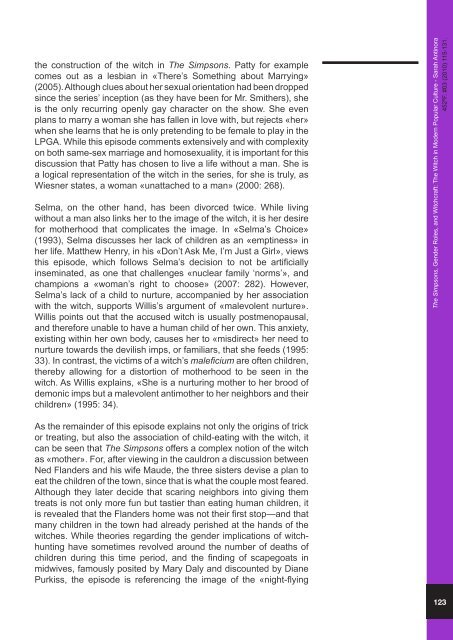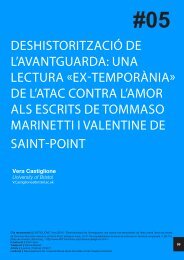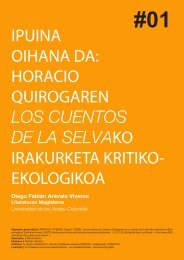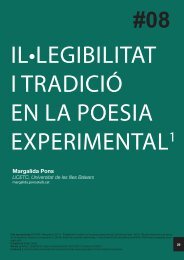03 - 452ºF
03 - 452ºF
03 - 452ºF
You also want an ePaper? Increase the reach of your titles
YUMPU automatically turns print PDFs into web optimized ePapers that Google loves.
the construction of the witch in The Simpsons. Patty for example<br />
comes out as a lesbian in «There’s Something about Marrying»<br />
(2005). Although clues about her sexual orientation had been dropped<br />
since the series’ inception (as they have been for Mr. Smithers), she<br />
is the only recurring openly gay character on the show. She even<br />
plans to marry a woman she has fallen in love with, but rejects «her»<br />
when she learns that he is only pretending to be female to play in the<br />
LPGA. While this episode comments extensively and with complexity<br />
on both same-sex marriage and homosexuality, it is important for this<br />
discussion that Patty has chosen to live a life without a man. She is<br />
a logical representation of the witch in the series, for she is truly, as<br />
Wiesner states, a woman «unattached to a man» (2000: 268).<br />
Selma, on the other hand, has been divorced twice. While living<br />
without a man also links her to the image of the witch, it is her desire<br />
for motherhood that complicates the image. In «Selma’s Choice»<br />
(1993), Selma discusses her lack of children as an «emptiness» in<br />
her life. Matthew Henry, in his «Don’t Ask Me, I’m Just a Girl», views<br />
this episode, which follows Selma’s decision to not be artificially<br />
inseminated, as one that challenges «nuclear family ‘norms’», and<br />
champions a «woman’s right to choose» (2007: 282). However,<br />
Selma’s lack of a child to nurture, accompanied by her association<br />
with the witch, supports Willis’s argument of «malevolent nurture».<br />
Willis points out that the accused witch is usually postmenopausal,<br />
and therefore unable to have a human child of her own. This anxiety,<br />
existing within her own body, causes her to «misdirect» her need to<br />
nurture towards the devilish imps, or familiars, that she feeds (1995:<br />
33). In contrast, the victims of a witch’s maleficium are often children,<br />
thereby allowing for a distortion of motherhood to be seen in the<br />
witch. As Willis explains, «She is a nurturing mother to her brood of<br />
demonic imps but a malevolent antimother to her neighbors and their<br />
children» (1995: 34).<br />
As the remainder of this episode explains not only the origins of trick<br />
or treating, but also the association of child-eating with the witch, it<br />
can be seen that The Simpsons offers a complex notion of the witch<br />
as «mother». For, after viewing in the cauldron a discussion between<br />
Ned Flanders and his wife Maude, the three sisters devise a plan to<br />
eat the children of the town, since that is what the couple most feared.<br />
Although they later decide that scaring neighbors into giving them<br />
treats is not only more fun but tastier than eating human children, it<br />
is revealed that the Flanders home was not their first stop—and that<br />
many children in the town had already perished at the hands of the<br />
witches. While theories regarding the gender implications of witchhunting<br />
have sometimes revolved around the number of deaths of<br />
children during this time period, and the finding of scapegoats in<br />
midwives, famously posited by Mary Daly and discounted by Diane<br />
Purkiss, the episode is referencing the image of the «night-flying<br />
The Simpsons, Gender Roles, and Witchcraft: The Witch in Modern Popular Culture - Sarah Antinora<br />
<strong>452ºF</strong>. #<strong>03</strong> (2010) 115-131.<br />
123










